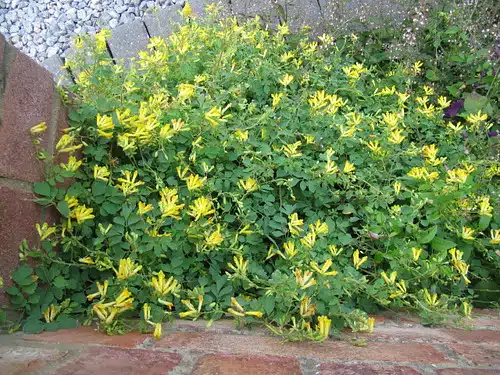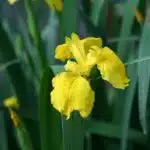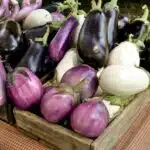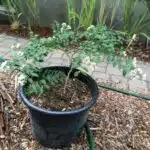Yellow Corydalis plants are a beautiful addition to any garden or landscape. These delicate plants are loved for their stunning yellow flowers that bloom in the spring and summer months. As a horticulturalist, I have seen many people struggle with growing these plants due to their specific soil and light requirements. In this article, I will share my expertise on how to successfully grow Yellow Corydalis plants.
To start, it is important to understand the specific needs of Yellow Corydalis plants. These plants thrive in well-draining soil that is rich in organic matter. They prefer partial shade or filtered sunlight, as direct sunlight can damage their delicate leaves and flowers. It is also important to keep the soil moist but not waterlogged, as too much water can cause root rot. By following these guidelines and implementing proper care techniques, you can enjoy the beauty of Yellow Corydalis plants in your own garden.
Understanding Yellow Corydalis Plants
It is no coincidence that the Yellow Corydalis plant has become a popular choice for garden enthusiasts. This herbaceous perennial not only boasts stunning yellow blooms but also offers several benefits to the landscape. As a member of the Papaveraceae family, this plant is native to Asia but can be found in various parts of the world.
One of the unique characteristics of Yellow Corydalis is its delicate foliage, which adds an airy texture to any garden bed or container. Additionally, it thrives in partial shade and moist soils, making it a suitable option for those hard-to-grow areas in your yard. Furthermore, this plant is perfect for attracting pollinators such as bees and butterflies to your garden.
To fully appreciate the beauty and benefits of Yellow Corydalis plants, it’s essential to understand how to grow them properly. In the next section, we’ll discuss how to choose the right location for planting these lovely perennials.
Choosing The Right Location For Planting
To ensure the success of your yellow corydalis plants, it is crucial to choose the right location for planting. One of the factors to consider is the amount of sunlight that the plant will receive. Yellow corydalis plants grow best in partial shade to full shade conditions. Too much sun can cause the plant’s leaves to wilt or turn yellow, while too little can result in spindly growth.
Another important factor to consider when choosing a location for yellow corydalis is soil pH. These plants prefer well-draining soil that is slightly acidic, with a pH range between 5.5 and 6.5. If your soil is too alkaline, you can amend it by adding organic matter such as compost or peat moss.
When selecting a location for planting, keep in mind that these plants do well in areas with good air circulation and moderate humidity levels. Avoid planting them in areas where water tends to pool or where there are low-lying spots that are prone to flooding. With proper care and attention, your yellow corydalis plants will thrive and add a vibrant pop of color to your garden.
- Consider the amount of sunlight that the plant will receive
- Ensure that soil pH ranges between 5.5 and 6.5
- Plant in an area with good air circulation and moderate humidity levels
With these factors in mind, you can now proceed with preparing the soil for yellow corydalis.
Preparing The Soil For Yellow Corydalis
As any seasoned gardener knows, the quality of soil is crucial to a plant’s growth and success. Testing the soil before planting yellow corydalis is an essential first step in ensuring optimal growth conditions. The pH level of the soil should ideally be between 6.0 to 7.5, which can be tested using a simple soil testing kit. Any imbalances in nutrients can also be addressed by adding organic matter such as compost or manure.
Once the soil has been tested and prepared, it is time for mulching techniques to come into play. Mulching helps retain moisture, regulate temperature, and prevent weed growth around the plants. Organic mulches like straw or leaves are preferable as they break down over time and add more nutrients to the soil. Inorganic mulches like plastic sheeting or rocks may not provide as many benefits but can still be used for aesthetic reasons.
To ensure that yellow corydalis blooms beautifully year after year, proper preparation of the soil through testing and mulching techniques is critical. A healthy bed of soil enriched with organic matter provides all the necessary nutrients to support optimal plant growth while minimizing water usage and weed control efforts. With this foundation laid out, selecting and planting yellow corydalis will be a breeze!
Selecting And Planting Yellow Corydalis
After the soil has been prepared, it is important to select and plant yellow corydalis in a suitable location. These plants prefer partial shade and moist, well-drained soil. It is also important to ensure that the planting area has good air circulation to prevent fungal diseases.
Yellow corydalis can be planted alongside other spring-blooming plants such as bleeding hearts, columbines, and hellebores. These companion plants not only complement the yellow flowers of corydalis but also share similar growing conditions. However, it is best to avoid planting them near aggressive spreaders like mint or invasive species such as Japanese knotweed.
Common problems with yellow corydalis include aphids, spider mites, and slugs. Regular inspection of the plants can help detect any issues early on. Insecticidal soap or neem oil can be used for pest control while handpicking or using slug baits can solve slug problems. With proper care and attention, yellow corydalis will thrive in your garden and provide a beautiful splash of yellow throughout the spring season.
Moving forward, watering yellow corydalis is crucial for their growth and survival. These plants require consistent moisture but must not be overwatered as this can lead to root rot. Therefore, it is recommended to water them deeply once a week during dry spells while ensuring that the soil drains well after each watering session.
Watering Yellow Corydalis Plants
- When watering yellow corydalis plants, water frequency should be determined by the soil moisture content.
- It is recommended to water the plants once a week, or when the soil moisture is low.
- The soil moisture should be monitored regularly, especially during the warmer months when water evaporates more quickly.
- Fertilizing is not necessary for yellow corydalis plants, but if used, it should be done about once a month.
- When fertilizing, organic fertilizer is recommended and should be applied to the soil surface and watered in.
- Yellow corydalis plants should be watered thoroughly, but not to the point that the soil becomes soggy.
Water Frequency
When it comes to watering yellow corydalis plants, it is important to understand the appropriate frequency. Too much or too little water can both harm these delicate plants. It is essential to maintain a balance between soil moisture and watering frequency.
Yellow corydalis plants require consistently moist but well-draining soil. Overwatering can lead to root rot, which can be fatal for the plant. On the other hand, underwatering can cause the plant to wilt and eventually die off. Therefore, it is crucial to monitor soil moisture levels regularly and adjust watering frequency accordingly.
Watering frequency largely depends on environmental factors such as temperature and humidity. During hot and dry weather conditions, yellow corydalis plants may require more frequent watering than during cooler months. A general rule of thumb is to water once or twice a week, ensuring that the top 1-2 inches of soil remain moist but not wet. By following these guidelines, you can maintain healthy yellow corydalis plants with vibrant blooms throughout the growing season.
Soil Moisture
Maintaining proper soil moisture is crucial for the growth and health of yellow corydalis plants. As a horticulturalist, it is important to understand the importance of soil moisture in relation to watering frequency. Consistently moist but well-draining soil is necessary for these delicate plants to thrive. However, overwatering can lead to root rot, while underwatering can cause wilting and eventual death.
To maintain appropriate soil moisture levels, it is essential to test the soil frequently. Yellow corydalis plants require consistently moist but not wet soil, which can be achieved by monitoring the top 1-2 inches of soil regularly. Soil testing allows for adjustment of watering frequency based on environmental factors such as temperature and humidity.
Mulching around yellow corydalis plants can also provide benefits in maintaining proper soil moisture levels. Mulch helps retain moisture in the soil, reduces weed growth, and regulates temperature fluctuations. As plant specialists, we recommend mulching with organic materials such as compost or shredded leaves that will break down over time and provide additional nutrients to the plant. By incorporating regular soil testing and mulching techniques into your plant care routine, you can ensure optimal soil moisture levels for healthy yellow corydalis plants with vibrant blooms throughout the growing season.
Fertilizing
Maintaining proper soil moisture levels is crucial for the growth and health of yellow corydalis plants. However, it is equally important to ensure that the soil is rich in nutrients required for optimal plant growth. As a horticulturalist, we recommend incorporating organic fertilizers into your plant care routine to provide essential nutrients to yellow corydalis plants.
Organic fertilizers provide numerous benefits over synthetic fertilizers. They improve soil structure, increase microbial activity, and enhance nutrient availability in the soil. Additionally, they release nutrients slowly over time, providing a steady supply of essential nutrients to the plant without causing over-fertilization or chemical burn. We recommend using organic fertilizers such as compost or well-aged manure for yellow corydalis plants.
It is essential to fertilize yellow corydalis plants at regular intervals throughout the growing season. We recommend applying fertilizer every four weeks during the growing season using a balanced fertilizer with equal amounts of nitrogen, phosphorus, and potassium (NPK). However, it is important not to over-fertilize as this can lead to excessive foliage growth at the expense of flower production. By incorporating organic fertilizers into your plant care routine and following a regular fertilization schedule, you can ensure healthy yellow corydalis plants with vibrant blooms throughout the growing season.
Fertilizing Yellow Corydalis Plants
As the old adage goes, “you are what you eat,” and this applies to plants as well. The importance of providing yellow corydalis plants with the necessary nutrients cannot be overstated. Proper fertilization is critical to achieving healthy growth, lush foliage, and vibrant flowers.
When it comes to fertilizing yellow corydalis plants, there are two main options: organic and synthetic fertilizers. Organic fertilizers are derived from natural sources such as compost or animal waste. They tend to release nutrients more slowly and promote soil health, but may not provide an immediate boost in growth. Synthetic fertilizers, on the other hand, are chemically formulated to produce quick results but can be harmful if overused.
Whichever type of fertilizer you choose, it’s important to follow the instructions carefully and avoid over-fertilizing. Too much fertilizer can burn the roots of your yellow corydalis plants and lead to stunted growth or even death. A balanced fertilizer with equal parts nitrogen, phosphorous, and potassium is a good choice for these plants. Fertilize once a month during the growing season for best results.
Moving on from proper fertilization techniques, pruning is another key aspect of growing healthy yellow corydalis plants. By removing dead or damaged plant material, you can encourage new growth and prevent disease from spreading. In the next section, we’ll discuss how and when to prune your yellow corydalis plants for maximum health and beauty.
Pruning Yellow Corydalis Plants
After fertilizing yellow corydalis plants, it is important to prune them properly to ensure their healthy growth. Pruning techniques differ depending on the type of plant and the desired outcome, but generally involve removing dead or damaged parts of the plant, cutting back overgrown branches, and shaping the overall structure.
Timing of pruning is crucial for yellow corydalis plants as they have a tendency to become leggy and overgrown if left unattended. The best time to prune these plants is in late winter or early spring before new growth begins. This will allow the plant to develop a more compact shape and produce more flowers during the growing season.
Pruning also helps stimulate new growth by encouraging healthy branching and foliage development. It also prevents diseases from spreading by removing infected or damaged parts of the plant. By following proper pruning techniques and timing, yellow corydalis plants can thrive and provide a beautiful display of vibrant, yellow flowers.
- Regular pruning promotes healthier growth
- Neglecting pruning can lead to disease spread
- Proper timing ensures optimal results
- Pruning helps maintain aesthetic appeal
Transition: While pruning can help prevent diseases from spreading, it’s important to also be aware of how to deal with pests and diseases that may affect your yellow corydalis plants.
Dealing With Pests And Diseases
Pest identification is an important step in preventing and controlling pests and diseases in yellow corydalis plants. Appropriate control methods should be chosen based on the type of pest identified and the severity of the infestation. Treating diseases in yellow corydalis plants requires an appropriate fungicide or insecticide, depending on the type of disease present. Preventing diseases in yellow corydalis plants can be achieved by providing the correct environment, such as proper drainage, adequate sunlight, and appropriate fertilization.
Identifying Pests
Identifying pests is an essential aspect of growing yellow corydalis plants. Pests can cause significant damage to the plant, leading to stunted growth, yellowing of leaves, and even death. As a horticulturalist or plant specialist, it is crucial to be able to identify the signs of pest infestation accurately.
One of the most common pests that affect yellow corydalis plants is aphids. These tiny insects feed on the sap of the plant and can spread diseases as they move from one plant to another. To identify aphids, look for clusters of small green or black insects on the undersides of leaves. Natural remedies such as insecticidal soap or neem oil can help control and prevent aphid infestation.
Another pest that can infect yellow corydalis plants is spider mites. These pests are so tiny that they are often difficult to spot with the naked eye. Look for webbing on leaves and stems or tiny white dots on leaves as these are signs of spider mite infestation. Preventive measures such as regularly spraying plants with water and keeping them free from dust can help keep spider mites at bay. In case of severe infestation, natural remedies like insecticidal soap and neem oil can help control them effectively.
In conclusion, identifying pests early in their development cycle is essential for maintaining healthy yellow corydalis plants. With natural remedies and pest prevention measures in place, one can ensure a healthy growing environment for these beautiful plants without harming the environment or other beneficial insects.
Controlling Pests
Controlling pests is an integral part of managing yellow corydalis plants. Pest infestations can cause significant damage to the plant and affect its overall health. As a horticulturalist or plant specialist, it is crucial to implement effective pest control measures to prevent further damage.
Natural remedies are an excellent option for controlling pests without harming the environment or beneficial insects. Insecticidal soap and neem oil are two natural remedies that have proven effective in controlling aphids and spider mites. These natural solutions work by suffocating the pests, causing them to die off without leaving behind harmful residues.
In some situations, chemical solutions may be necessary to control severe pest infestations. Chemical pesticides should only be used as a last resort as they can harm beneficial insects and impact the environment negatively. If chemical solutions must be used, it is essential to follow proper safety protocols and use them sparingly to minimize their impact on the ecosystem.
Propagating Yellow Corydalis Plants
As a horticulturalist, I often see the growth of plants as a metaphor for life. Just like how we need to nourish ourselves with food and water, plants also require proper care and attention to thrive. And just like how we reproduce to continue our legacy, plants also propagate to ensure the survival of their species. Propagating yellow corydalis plants is one way to enjoy their beauty while also contributing to their preservation.
Benefits of propagation include having more yellow corydalis plants for your garden, as well as being able to gift them to friends and family. Additionally, propagating can help prevent the loss of rare or endangered plant species by providing more opportunities for them to grow in different locations. Common propagation methods include seed sowing and division.
Seed sowing involves planting seeds in soil or compost and keeping them moist until they germinate. Division is when you separate an established plant into smaller sections and replant them in other areas. Both methods require patience and attention to detail but can be rewarding in the end when your garden is filled with beautiful yellow corydalis blooms. With these propagation techniques, you can enjoy the beauty of yellow corydalis plants in your garden while also contributing to their conservation efforts.
Enjoying The Beauty Of Yellow Corydalis Plants In Your Garden
Yellow corydalis plants are a delightful addition to any garden, bringing bursts of bright yellow color that can light up even the dreariest of spaces. These hardy perennials are relatively easy to grow, making them a great choice for novice gardeners and seasoned horticulturalists alike. With the right care and attention, you can enjoy the beauty of yellow corydalis plants in your garden for years to come.
To grow yellow corydalis plants successfully, it’s important to choose a location that receives plenty of sunlight but is also well-drained. These plants prefer moist soil but do not tolerate waterlogged conditions well. Adding organic matter such as compost or manure to the soil can help improve drainage and provide essential nutrients for optimal growth. Once established, yellow corydalis plants require minimal maintenance beyond regular watering and occasional fertilization.
Creating arrangements with yellow corydalis is an excellent way to showcase their vibrant color and delicate flowers. These plants work well in floral designs alongside other spring-blooming favorites like daffodils and tulips. Their airy foliage also adds texture and depth to arrangements, making them a versatile option for creative florists looking to add interest to their designs. Whether grown in the garden or used in floral arrangements, yellow corydalis plants are sure to bring joy and beauty wherever they are found.
Conclusion
Yellow corydalis plants are a beautiful addition to any garden. As a horticulturalist, it is important to understand the needs and requirements of this plant in order to grow it successfully. Choosing the right location for planting, preparing the soil, selecting and planting the yellow corydalis, watering and pruning are all essential steps in caring for this plant.
Firstly, ensure that you select a location with partial shade or filtered sunlight. The soil should be well-draining and rich in organic matter. Once you have prepared the soil, select healthy yellow corydalis plants from a reputable nursery and plant them at least 12 inches apart. Water your plants regularly but avoid overwatering as this can lead to root rot.
Pruning is also important as it encourages new growth and prevents the plant from becoming too leggy. Keep an eye out for pests like aphids and slugs which can damage your yellow corydalis plants. Lastly, propagating your yellow corydalis is easy by dividing mature clumps or taking stem cuttings.
In conclusion, growing yellow corydalis plants requires attention to detail and care. By following these steps, you can enjoy their beauty in your garden year after year. Remember to choose the right location, prepare the soil properly, water regularly but not excessively, prune when necessary, watch out for pests and diseases, and propagate when needed. Happy gardening!
Image Credits
- “Corydalis lutea (Yellow Fumitory)” by wallygrom (featured)





























